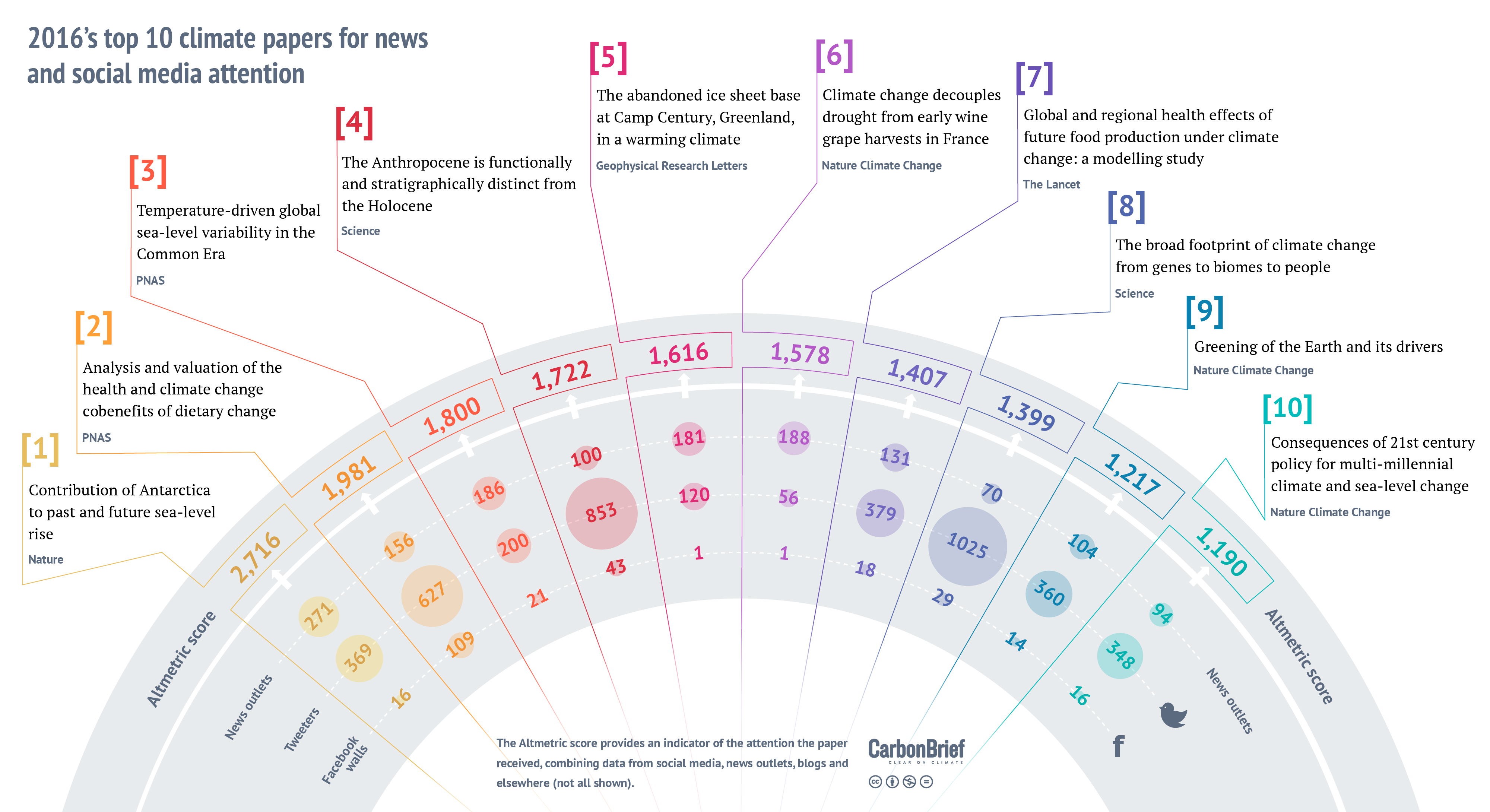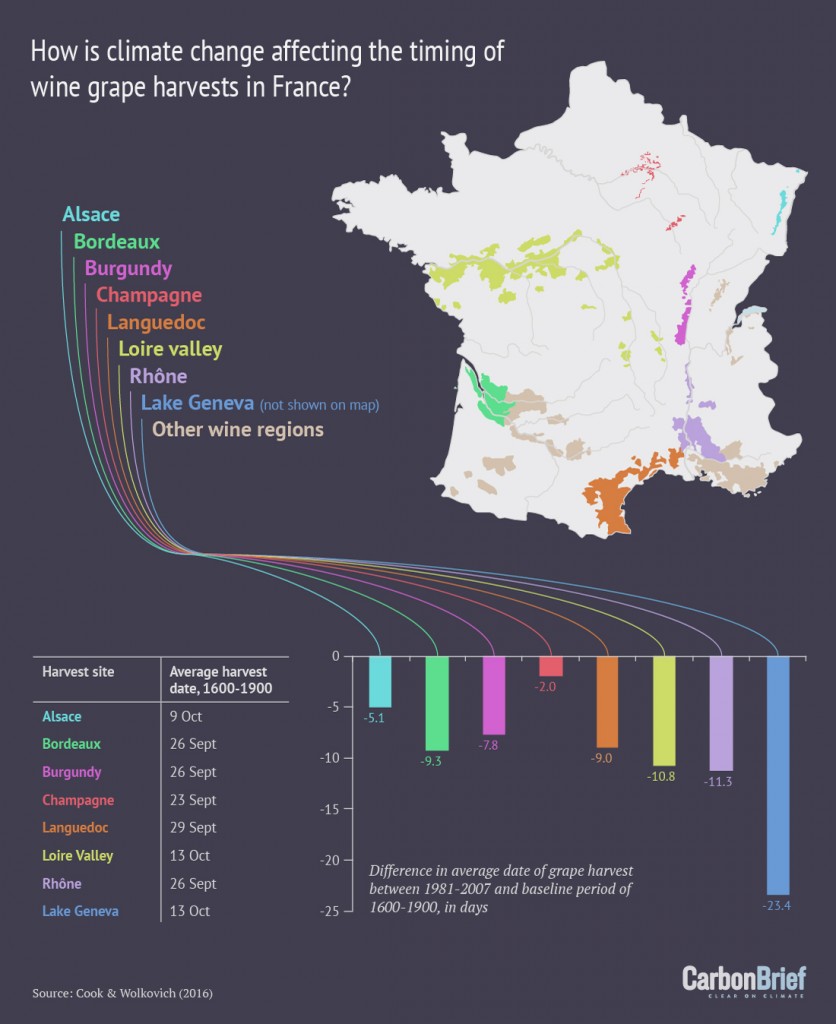Robert McSweeney
12.01.2017 | 2:55pm
Every year, thousands of scientific journal papers are published by researchers across the world, but only a tiny proportion make it into the pages of the newspapers.
Using Altmetric, we’ve compiled a list of the 25 most talked-about climate papers of 2016. You can see the Top 10 in our infographic above (zoomable version here).
Altmetric scores academic papers based on how many times they’re mentioned in online news articles and on social media platforms. You can read more about how the Altmetric scoring system works in last year’s article.
Top of the table
The highest scoring article of the year, with an Altmetric tally of 2,716, is the Nature paper “Contribution of Antarctica to past and future sea-level rise”, by Prof Robert DeConto of the University of Massachusetts and Dr David Pollard of Penn State University.
Published in March, the study found that Antarctica has the potential to contribute more than a metre of sea level rise by 2100 and more than 15 metres by 2500, if greenhouse gas emissions continue unabated.
The paper had more coverage in the news than another other climate paper published in 2016. It was featured in 386 news stories and was covered by – among 271 outlets in total – the BBC, Guardian, MailOnline, Independent, Huffington Post, New York Times, Washington Post and the New Yorker.
The study made a particular splash in the US after further analysis, published in August by estate agent firm Zillow, highlighted that 1.8m of sea level rise by 2100 could put two million American homes underwater.
The paper – not the news stories – was also tweeted from 369 accounts and posted on 16 Facebook walls. Overall, the paper’s score puts it in the top 5% of all journal articles in the Altmetric database.
Runner-up
In second place is “Analysis and valuation of the health and climate change cobenefits of dietary change”, by lead author Dr Marco Springmann from the Oxford Martin Programme on the Future of Food at the University of Oxford.
This paper was published in March in the Proceedings of the National Academy of Sciences of the United States of America (PNAS), which also landed a paper in second place in last year’s list.
The research found that a worldwide switch to diets that rely less on meat and more on fruit and vegetables could reduce global mortality by up to 10% and food-related greenhouse gas emissions by up to 70% by 2050.
The paper’s overall Altmetric score of 1,981 includes 203 new stories from 156 news outlets, as well as 660 tweets from 627 users. This paper scored highest for Facebook, with 115 wall posts from 109 people.
Part of the popularity of the paper stems from being referenced in a press release for the “Kickstart Your Health Rochester” programme in which doctors in New York encouraged local residents to adopt a vegan diet for three weeks in May to improve their health.
Third place
Coming in third is another PNAS paper, “Temperature-driven global sea-level variability in the Common Era,” by lead author Dr Robert Kopp of Rutgers University.
The study compiled the first-ever estimate of global sea level change over the last 3,000 years. Their headline finding – that the speed of rising seas in the 20th century was faster than during any of the previous 27 centuries – generated headlines around the world, from the Boston Globe and Bangkok Post to Le Monde and the Hindu.
With a total score of 1,800, this paper appeared in 228 news stories from 186 outlets, was tweeted by 200 users, and posted on 21 Facebook walls.
Just missing out on the medals
In fourth place, published at the very beginning of 2016, is “The Anthropocene is functionally and stratigraphically distinct from the Holocene” in Science.
This study presented evidence that the impact of humans on the Earth is so severe and so enduring that the geological time period since the mid-20th century should be declared the “Anthropocene”.
This paper was one of the most tweeted about in our Top 25, with 904 tweets from 853 users, reaching a potential of more than three million followers.
The Anthropocene was also the subject of a feature article in Carbon Brief in October, which explored the history of the idea and the debate among geologists on whether they will formally inscribe a new epoch into their books.

Infographic: The Anthropocene. By Rosamund Pearce for Carbon Brief.
In fifth is a paper that sounds like it could be the plot of a James Bond film. “The abandoned ice sheet base at Camp Century, Greenland, in a warming climate”, published in Geophysical Research Letters, assessed the possible fate of a US military base built in 1959 beneath the surface of the Greenland Ice Sheet.
This nuclear-powered “city under the ice” doubled as a top secret site to study the feasibility of deploying missiles from the Arctic. The base was abandoned in 1967, under the assumption that all its chemical, biological, and radioactive wastes would forever be preserved in ice. However, the study shows that ice sheet melt as a result of climate change could uncover these wastes by the end of the century.
Completing the Top 10
Elsewhere in the Top 10, coming sixth is “Climate change decouples drought from early wine grape harvests in France” in Nature Climate Change.
This research found that increasingly hot summers are pushing wine grapes in French vineyards to mature earlier in the year. While this could bring some good years for French wine in the near future, it doesn’t bode well for the longer term, the researchers told Carbon Brief when we covered the paper in March.
The study was the second-most covered in the news of our Top 25, presumably because the fate of wine is a subject close to the hearts of many.

Infographic: How is climate change affecting the timing of wine grape harvests in France? Credit: Rosamund Pearce/Carbon Brief. Data: Cook & Wolkovich (2016).
The topic of the paper in ninth place is quite a hot potato in climate science. “Greening of the Earth and its drivers”, published in Nature Climate Change, showed that up to half of the Earth’s vegetation-covered land is now “greener” than it was 30 years ago – mostly caused by rising CO2 levels in the atmosphere.
But any benefits of “CO2 fertilisation” may be temporary and are outweighed by the negative consequences of climate change, one of the authors told Carbon Brief.
And while the general principles of CO2 fertilisation are known, there is still much to learn about how these processes will act in future as the world continues to warm, said Prof Richard Betts, head of climate impacts research at the Met Office Hadley Centre, in a guest post for Carbon Brief.
Completing the Top 10 is “Consequences of twenty-first-century policy for multi-millennial climate and sea-level change” in Nature Climate Change. The paper aimed to tackle the “misleading impression in the public arena” that human-caused climate change is merely a 21st century problem.
Projecting changes in temperature and sea levels for the next 10,000 years, the researchers find that greenhouse gas emissions could eventually lead to 7.5C of warming and global sea level rise of 25-52m. With such stark results, it’s no surprise that the paper caught people’s attention.
Final score
If you want a closer look at the final scores, we’ve compiled all the data for the Top 25 climate papers of 2016 here. And there’s just space for a few honourable mentions…
Just missing out on the Top 10 in 11th place is “Observed Arctic sea-ice loss directly follows anthropogenic CO2 emission” in Science. This novel study calculated that for every tonne of CO2 emitted into the atmosphere, summer sea ice cover in the Arctic shrinks by three square metres.
Number 14 on the list is “Evidence for climate change in the satellite cloud record”, published in Nature, which used satellite data to gather evidence on how cloud patterns have changed in recent decades. The findings are another “brick in the wall” that “supports our confidence in the mainstream view of climate science,” a scientist not involved in the study told Carbon Brief.
Last month, scientists from the University of East Anglia and the Global Carbon Project released their annual stocktake of global CO2 emissions. Their paper, “Global Carbon Budget 2016”, published in Earth System Science Data, comes in 16th for 2016.
Their figures revealed that the amount of CO2 we put into the atmosphere from burning fossil fuels, gas flaring and cement production has held steady for three years in a row. But it’s too early to say whether this constitutes a peak in global emissions, one of the scientists told Carbon Brief.
Elsewhere in the Top 25 are “Millions projected to be at risk from sea-level rise in the continental United States” in Nature Climate Change (21st), and “Climate change: The 2015 Paris Agreement thresholds and Mediterranean basin ecosystems” in Science (25th). You can read more about both in our coverage here and here, respectively, when the papers were originally published.
Overall, the Top 25 is made up of six papers each from journals Science and Nature Climate Change, followed by three in Nature, two each in Environmental Research Letters and PNAS, and one in each of Earth System Science Data, Geophysical Research Letters, Nature Geoscience, Progress in Human Geography, Science Advances, and The Lancet.
Top infographic by Rosamund Pearce for Carbon Brief.

